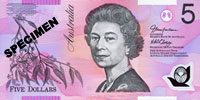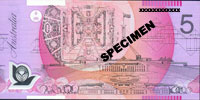Currency index
Advertisements
Australian five dollar note(Second series)

Quick links to banknotes
Third series(2016–present)





Second series(1992–present)




Description:
Size: 130 x 65mm
Paper type: Polymer
Main colour: Violet, pink


The Australian 5
dollar note was first issued in 1967, one year after the currency was
changed from the Australian pound to the Australian dollar on 14 February 1966.
It was a new denomination, with a new mauve
colouration. There have been five different issues of this denomination:
-
A paper note which had a gradient of mauve, with a distinct black overprint.
-
The first polymer issue, which can be recognised for its distinct mauve
colouration and numeral font, was first issued in pale mauve (1992). It was
soon discovered that ultra-violet light degraded the ink bond and that a note
in circulation for any moderate period of time could have elements scratched
off with a fingernail, for example.
-
In 1995, a second polymer issue was created, distinguishable by its deeper
shade and different font for the numeral.
-
A federation commemorative 5 dollar note was issued in 2001 for that year only. Notes
featured Sir Henry Parkes on the obverse and Catherine Helen Spence on the
reverse.
- The new Australian five-dollar polymer banknote was issued on 1 September 2016. It retains the portrait of Queen Elizabeth II, which is drawn from the same source photograph represented on the first polymer five-dollar banknote.
Since the start of issuance there have been sixteen signature combinations, of which the
1967 issue is of the greatest value, issued for two years only; and the 1990
Fraser/Higgens being issued for less than a year. From 1967 to 1974, the main
title identifying the country was "Commonwealth of Australia" and there were
195,504,000 notes issued in its life. This was subsequently changed to
"Australia" until the end of the issuance of paper currency for this
denomination in 1992 with 978,068,318 of these notes being issued.
According to Reserve Bank statistics, at the end of
June 2015 there was a net value of $823 million in Australian 5 dollar notes in circulation, with
a 1% cash value of all issued currency. Actual banknotes in circulation
account for 12% of all denominations, or 116 million notes.
In 2014/15 around 78 counterfeit 5 Australian dollar banknotes, with a nominal value of $390, were detected in circulation.
Security Features:
For detailed visualization of security concept go to 50 Australian dollar note
The Australian 5 dollar Second series note incorporates the following security features:
- The clear window which contains a stylised gum flower printed in it (and can be seen from either side)
-
When the Australian 5 dollar note is held up to the light,
a seven pointed star within a circle is formed by four points on one side of the banknote combining perfectly with three points on the other.
-
When the banknote is held up to the light also, an image of the Australian Coat of Arms can be seen under other printing.
-
The words 'FIVE DOLLARS' are microprinted and can be seen with the aid of a magnifying glass.
-
Slightly raised printing that can be felt with the fingers is used for the portraits and other major design elements.
-
Intricate multi-coloured fine-line patterns and images appear on each side.
-
Under ultra-violet light, the serial number fluoresces and a square patch becomes visible on the back of the banknote.
rba.gov.au
wikipedia.org




Follow currencyguide.eu